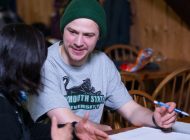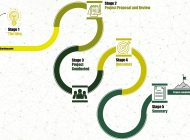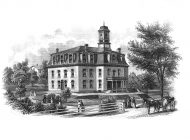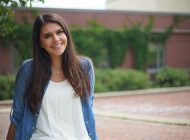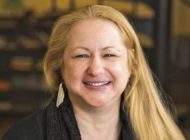A Conversation with PSU’s 15th President Donald Birx
■ Lori L. Ferguson

“Individuals between the ages of 20 and 27 are at their most creative and energetic, what better way to direct that energy than into educational initiatives and experiences that will set the students up for success?” says Birx. Kaleb Hart ’11 photo.
Walking into the third-floor office suite of Plymouth State University’s newly appointed president, the impression is immediate: this is a place of creativity and vision. Beautiful artwork by Plymouth State students occupies places of pride on virtually every surface—paintings and photographs adorn the walls and three-dimensional ceramic pieces rest on pedestals scattered about the space. There’s a relaxed rhythm here, underpinned by a quiet energy and a willingness to explore new connections. As it turns out, the setting is a remarkably apt reflection of the new man in the corner office: Dr. Donald Birx.
Birx is a soft-spoken individual with an easy smile and a barely contained excitement for the task at hand. He holds a PhD in electrical engineering and an MBA in finance and has spent as much time in private industry as he has in academia. “I try not to let my industry experience get in the way,” he says with a wry chuckle. In reality, Birx observes, he has found his lengthy experience in both sectors to be a tremendous asset. “There’s a real need for universities to intersect with their surrounding communities and the industries and non-profits therein,” he asserts, “and having depth of experience in both business and academia helps me to see both sides of the equation.” In today’s fast-moving, highly interactive global economy, there’s a huge need to make sure students are equipped with the interdisciplinary tools and experiences to thrive, Birx says, and this is precisely the goal that he has set for himself as Plymouth State’s 15th president.
“I’m excited about what can be accomplished when we bring education and business together in innovative ways,” Birx observes. “The synergy is incredibly powerful and the opportunities created are transformative—for ourselves, our students, and our community.”
Birx was drawn to Plymouth State, he says, for a number of reasons, not the least of which is the region’s natural beauty. “Having lived all over the country, you get a sense of what you like, and my family and I immediately fell in love with both the location and setting of this place.” Birx, his wife, and four adult children enjoy such outdoor activities as skiing, swimming, kayaking, and hiking, as well as an occasional trip to the city. “The geography here is beautiful,” he notes, “and the remoteness is just right—we’re close to the city, but not right in it.”
Birx was equally taken with the University. “The campus is beautiful, the quality of the faculty, staff, and students is high, and the desire to be the best you can be is pervasive,” he says. “I want everyone to know how truly special Plymouth State is.”
Moved by the depth of talent and openness to new ideas he encountered, Birx realized that Plymouth State’s desire to chart a new course into the future was a wonderful fit with his own vision for creating the dynamic learning environment that’s needed to prepare students for success in the twenty-first century. He began his tenure as president on July 31, and has already started on an ambitious path to success.
Strengths across disciplines
Birx believes that the secret to making Plymouth State a model of the modern, twenty-first-century residential university revolves around two seminal concepts: clusters and the open lab.

President Birx greets first-year student Alexandria Fortier (right) and her mother at Move-in Day 2015. Bruce Lyndes photo.
“I started experimenting with the concept of clusters in 1996,” he explains, “and after 20 years of working in these intersecting areas, I’ve seen how powerful the concept can be and I know that Plymouth State is a place where the idea can be fully realized.” There are many institutions across the country that have implemented the cluster concept as a part of their programs, but they are still heavily discipline-based overall, Birx notes. Few places have created a holistic relationship between disciplines, the university, and the community in which it resides based on the cluster and open lab model. This is the model that Birx envisions for Plymouth State.
The idea behind clusters is fairly straightforward, Birx explains. You pull together unique strengths across disciplines from the community, the university, and regional businesses and non-profits that complement core competencies within the university and sectors of opportunity globally. This creates a locus of education and activity that matches the challenges and needs of the twenty-first-century economy that graduating students will enter. Birx says it will allow PSU to be incredibly creative and to establish more programs that are leaders nationally and internationally. It also gives students broad areas of interrelated studies as well as discipline-based majors from which to choose. Over the course of the next nine months, Birx plans to work closely with Plymouth State faculty and staff to define a series of five to seven clusters that build upon the University’s unique strengths, together with those of the communities within a two-hour drive of Plymouth.
Art and technology, he says, offer a perfect example of a potential new cluster. “The region within a two-hour driving radius of Plymouth—from the North Country to greater Boston—is widely recognized as a very strong arts region, and the arts are a core competency here at Plymouth State as well. Technology is an equally powerful player in the region—Boston is a technology hub and competency in this sector is critical for our students.” Therefore, Birx says, an arts and technology cluster is among those being considered. The arts are a key STEM field, though they are seldom thought of in this manner. The two disciplines absolutely complement one another. For example, the combination is critical in new product design, advanced manufacturing, entertainment, information presentation, analytics, modeling and simulation, and developing training scenarios—and the combination offers platforms for individuals from education, industry, and the community to work and learn together in highly creative and meaningful ways.
“My background is in complex systems and artificial intelligence,” Birx continues, “so I’ve witnessed firsthand the ways in which many different pieces can come together, creating an epiphany of discovery and energy where the whole is greater than the sum of its parts. Processes become interlinked, feedback loops develop, ideas and concepts begin to intersect in a self-reinforcing manner, and big changes happen! The once disparate slices of general education and the world around us become themed coursework within a clustered framework.”

This year’s Evening of Connections was President Birx’s first opportunity to speak with donors and student scholarship recipients and their families. Kaleb Hart ’11 photo.
The benefits of combining seemingly divergent strands of study through a cluster are further enforced through open labs—environments in which classroom learning is combined with hands-on exploration and real-world challenges through interactions across disciplines and among students, faculty, staff, alumni, and members of the community. Birx witnessed the potential for learning and development represented by open labs during his tenure at the University of Houston, where he co-founded the Center for Industrial Partnerships, as well as at Pennsylvania State University’s Behrend College, where he co-founded the Advanced Manufacturing and Innovation Center. “These centers were founded to provide pathways for members of the community to come in to open laboratory environments to work alongside students and faculty to create capstone projects, develop new product ideas, or solve challenges in their businesses. It quickly becomes not only an integrated way of learning but also one that is self-perpetuating and entrepreneurial. Businesses and other community organizations realize the value of educating students in this way and begin investing in departmental programs, work-study initiatives, design centers, and scholarships. Students recognize the benefits as well, gathering valuable knowledge through their coursework and then applying that knowledge and cultivating critical-thinking skills in real-world situations.” As a result, Birx says, students graduate with a potent combination of education and practical experience that allows them to integrate knowledge across disciplines and work successfully in a team environment to create things and get things done. “It is a more comprehensive experience than typical internships and traditional student engagement opportunities.”
Birx says that he has also seen this experiential learning model bear fruit in hard dollars and cents. “When I arrived at the University of Houston in 2006, the university was collecting approximately $300,000 a year in licensing fees from collaborative endeavors between the school and private industry,” Birx notes. “When I checked a year ago with my colleagues at UH, that number had climbed to approximately $16 million per year, due in large part to the visionary leadership at UH and the number of collaborative relationships between the university and the community that were fostered at the Center for Industrial Partnerships as well as in open laboratories based on clusters.”
Individuals between the ages of 20 and 27 are at their most creative and energetic, Birx asserts; what better way to direct that energy than into educational initiatives and experiences that will set the students up for success? “If you look back in our history to the founding of the first land grant universities under the Morrill Act of 1862, you quickly realize the transformative power of bringing universities, government, and business together to tackle problems and move the economy forward—the intersection of knowledge and practice is incredibly powerful.”

“I’m excited about what can be accomplished when we bring education and business together in innovative ways,” Birx observes. John McKeith photo.
The public universities of the late nineteenth century were founded, Birx notes, to educate farmers, research the best methods for sustainable productivity growth in agriculture, and train those coming out of a rural environment to be leaders in the nascent industrial economy. The universities became the open laboratories where industry and education met and where the barriers between research and practice, industry and academia, and learning and doing were lowered. And the results were staggering. Within the century, the United States emerged as the world leader in agriculture and manufacturing. “We not only fed ourselves and our growing population, we fed the world,” Birx says. “We not only made things, we were the place to come for the latest in creative ideas.” Indeed, he says, it’s estimated that 85 percent of our economic growth came about as a result of our ability to create and make things through technology and creative thinking across disciplines. Even today when other countries talk about our future leadership in the global economy, it always revolves around our creativity.
In the intervening years, the US has lost a bit of this edge, Birx observes, but he is confident that through a return to a revitalized, twenty-first-century interpretation of the open laboratories concept for universities, we can regain it. “When we all work together, the results are transformative—we’ve seen it happen in our country before, and we can see it happen again. My goal as president of Plymouth State University is to demonstrate how partnerships that capitalize on the synergy between learning and doing can make a profound difference in our world.”
Once the ball is rolling, Birx continues, the benefits quickly follow. The community becomes more involved with the university, the university prospers, local and state governments recognize in a more substantive way the relevance of higher education, and students receive an education that feeds their interests and allows them to make a positive impact in their communities.

President Birx with John ’85 and Carrie Morgridge, the president and vice president, respectively, of the Morgridge Family Foundation. Through the foundation, the Morgridges have supported several successful initiatives at PSU, including the Student Support Foundation, which recently celebrated its 10th anniversary. Kaleb Hart ’11 photo.
Working together
Alumni play a pivotal role in this process, Birx notes. They’re already living and working in the community and can help to spread word of the University’s mission as well as facilitate relationships between the school and their particular organizations. “Alumni are in the community as business owners, legislators, volunteers, donors, and employees, and they have firsthand experience with the University’s strengths and abilities, so they’re ideal ambassadors.”
Donors are another important constituency, Birx says, and their involvement in remaking Plymouth State into the university of the twenty-first century is equally critical. “Donors want to be part of creating something,” Birx says, “and when they see where their dollars can have an impact and make a difference, they’re energized. When donors see the way in which clusters enable students to obtain a strong foundation in the liberal arts together with critical-thinking skills and real-world experience, they’re moved to engage. Basing our educational model on the concept of clusters and open labs allows us all to dream again about what we want to be and do, and it’s incredibly compelling and liberating.”
Plymouth State’s motto is Ut prosim (That I may serve), Birx notes, and it’s one that he loves. “I think it really goes to the essence of what a leader should be about, and my mission is to give that motto focus. I want to challenge our faculty, staff, students, and alumni to think hard about the broad picture: ‘How might we best serve in this coming century?’ ‘Who are we serving?’ I want Plymouth State to continue to serve our community in a way that’s creative, meaningful, and transformative.
“I truly believe that you can create the best thing in the world, but if you haven’t done it in a way that enhances people’s lives and brings them together, what value is it?” Birx concludes. “I care about people and what they can become, and I believe that we can achieve greater things collectively than we can individually. Working together, I know that we can position Plymouth State University as a role model for other institutions of like size. We can provide an example of how residential universities can partner with their communities to provide experiences that are transformative—for ourselves, our students, and the communities in which we live.”
Lori L. Ferguson is a freelance writer based in southern New Hampshire. She enjoys writing on lifestyle and health and wellness topics, as well as all things artistic.
Tags: 15th president clusters Donald Birx experiential hands-on interdisciplinary leader Leadership open lab partnerships real-world






